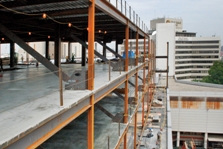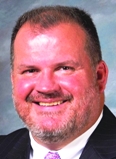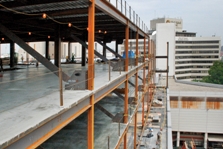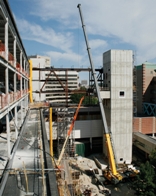
An Expansion Built on Safely
OH&S: Tell me about Shawmut's safety record and commitment to safety.
 John Neil: We've got eight overall values. And safety is actually a stand-alone value. It's basically a personal statement by every employee: We're committed to providing co-workers, subcontractors, clients, and general public with a workplace environment that's free from hazards and risk. That's a priority each and every day, to make sure every person working with or for Shawmut goes home safely, without accident or incident. They're empowered and responsible for enforcing Shawmut's zero accident, zero tolerance policy. So it really begins there. It's not a narrative just for field operations or construction operations; each and every employee has that commitment to a shared value. And we don't put safety first, but safety is right there with profitably, quality, diversity -- every other value we have in the company. Really, that is the springboard to what I would say is much better-than-average safety results in performance, significantly below average on our EMR and incident rates. For 2007, total recordables were 2.06, our DART was 1.26. So, again, significantly better than average for the construction niche we're in.
John Neil: We've got eight overall values. And safety is actually a stand-alone value. It's basically a personal statement by every employee: We're committed to providing co-workers, subcontractors, clients, and general public with a workplace environment that's free from hazards and risk. That's a priority each and every day, to make sure every person working with or for Shawmut goes home safely, without accident or incident. They're empowered and responsible for enforcing Shawmut's zero accident, zero tolerance policy. So it really begins there. It's not a narrative just for field operations or construction operations; each and every employee has that commitment to a shared value. And we don't put safety first, but safety is right there with profitably, quality, diversity -- every other value we have in the company. Really, that is the springboard to what I would say is much better-than-average safety results in performance, significantly below average on our EMR and incident rates. For 2007, total recordables were 2.06, our DART was 1.26. So, again, significantly better than average for the construction niche we're in.
Health care is a growing business for us. The success we had at Rhode Island Hospital, we hope to mirror and have it play out all across the country. We’ve got a couple of other big health care jobs going on right now, one just down the road at Tufts Medical, which is a very similar project to RIH in that we're stacking floors on top of existing floors. The best practices we've learned, particularly from a safety standpoint, down at Rhode Island Hospital, we're able to replicate.
What are those lessons you've learned?
Neil: We're trying to duplicate a lot of the success we had at Rhode Island Hospital, and I'm really thinking of the pre-construction and pre-planning phase of that. I think, far and away, the collaboration with the owner group, our client, the architect, all of our major subcontractors on the project, but also regulatory agencies – city of Providence, fire department, OSHA – particularly the OSHA area director for Rhode Island. We got heavily involved very early in the pre-construction effort to preplan some of the logistical risk we knew we were going to face when faced with a 90,000-square-foot vertical expansion over a working hospital.
 And not just a working hospital, but a busy Level 1 trauma center and surgical suite. So knowing those potential risks going in led us down the path of, "We've got to focus on pre-con and pre-planning, get all of the stakeholders involved in that process." And we could build some consensus on just what sequencing and job hazard analysis needed to be.
And not just a working hospital, but a busy Level 1 trauma center and surgical suite. So knowing those potential risks going in led us down the path of, "We've got to focus on pre-con and pre-planning, get all of the stakeholders involved in that process." And we could build some consensus on just what sequencing and job hazard analysis needed to be.
And I've got to tell you, we had huge cooperation from all of those entities. Some might say it's a job that's easy to do with those in our control, those being the subcontractors, but we had complete cooperation from our client and from the other agencies that I mentioned to really work a detailed pre-plan to address those risks.
And you're doing the same thing at Tufts?
Neil: Exactly. And there, we had an added risk component, if you will, of a tower crane at Tufts. With all of the horror stories we've been hearing in the safety world with cranes, we magnified the pre-planning effort with our tower crane operation.
You're right about the crane headlines that have been so prominent for the past year. Is the Tufts jobs as big, in square footage?
Neil: It is as big. Project dollars are plus or minus $10 million or so, and the square footage is pretty close.
Have these jobs been taking place in winter? Hvae you been dealing with weather hazards?
Neil: Right now, in fact, we're going through a glazing phase and probably have our crane out there well into March. So we're up against it right now with the conditions, and particularly with our glaziers. So we're dealing with the elements as we speak.
I guess weather patterns are always present, given your location?
Neil: We're in 42-plus states across the country, so all sorts of weather extremes are presented in all of our work.
How big is your department, if you have that many operations taking place all over the country? Do you have a lot of people in the field?
Neil: We have a national safety organization. We've got full-time regional safety managers in Vegas, another in New York City, and then also four additional safety managers in Boston who travel, as well. So we have a department of six safety managers and a few safety coordinators, and we also leverage some professional consultants in remote locations.
As you said, you're employee-owned and that’s a value for you. So I assume when you bring a contractor or an employee on a project, that's instilled in them from day one.
Neil: That's it for us. With a staff of nine, we may do at any one time greater than 400-plus projects. We need to be decentralized from not just a safety value, but really holding entire project teams accountable for safety performance. We spend a great deal of time managing that performance. Another huge part of our time is in education and training. And we've got more than 9 percent of our field staff with OSHA 30 certification and our construction operations side, probably 70 percent of so. These would be the CMs and those that work from the office.
I'm impressed. I assume the value and a lot of that was in place when you arrived?
Neil: It has been a continuous learning experience for our organization. We have put in some newer program components, newer proceses, including subcontractor prequalification, just recently. Our president, Bill Hughes, together with our CEO, Tom Goematt -- it really starts at the top. They have become the voice of our safety performance prior to my arrival, but I've used that voice to leverage our performance.
That is invaluable, I agree with you. You've got to get top management commitment and real passion about it. And if you get that, you can go a long way. In what ways do you get to your employees? Email, annual meetings, quarterly meetings, Web meetings? How do you get the message out and stay in touch with what's going on?
Neil: Let's start with our field operations side, particularly our construction managers and superintendents. We bring them into the office here in Boston for the educational component, be it OSHA 10 or 30, first aid, CPR. We've got a number of different training modules that all of our staff are required to be a part of. That's done in house.
Further, we’re making field visits to different projects for project safety orientations. We will do education for our subcontractors on site, as well. And not just with our safety staff, safety managers. We sort of do a train-the-trainer for our CMs and superintendents to handle some of that. We have ongoing kickoff meetings, ongoing monthly operations meetings. And then closeout meetings. There really are multiple opportunities to engage with field operations from a safety standpoint. Obviously, each job has a pre-construction kickoff meeting.
Our [project executives], PMs, estimators – we have weekly scheduling meetings where safety is on the agenda. So we know on a very detailed basis what’s going on with each and every project, not just from a production and a quality and financial standpoint, but also from a safety standpoint. And those are held with each group every single week. You can imagine during our high season, with 400-plus projects doing on, those sort of meetings on a weekly basis are pretty intense, and a lot of detail is going on in them.
What happens when a job changes midstream?
Neil: That happens a lot. Delivering world-class client service above all else is also a Shawmut value, and predictably, we have job changes, and scope changes, and schedule changes. All sorts of changes, including financial changes, happening each and every day. The project team has to be completely up on those. . . . I think communication is the key to driving that so there are no surprises.
How many employees do you have, and how many subcontractors does Shawmut employ?
 Neil: Currently we're about 1,000 employees. Subcontractors vary during the course of a year, but we're talking well over 5,000 subcontractors that we might engage at some point in time. You do the quick math: 400-plus projects, and generally anywhere from 20 to 25 core subcontractors.
Neil: Currently we're about 1,000 employees. Subcontractors vary during the course of a year, but we're talking well over 5,000 subcontractors that we might engage at some point in time. You do the quick math: 400-plus projects, and generally anywhere from 20 to 25 core subcontractors.
In the major areas that we're currently in -- Boston, Northeast, New York City, mid-Atlantic, Vegas, California -- a heavier concentration in those areas, obviously. There's a lot that has to be done from a management standpoint, from process, from an accountability standpoint. We use our best practices to drive that same consistency through to our subcontractors, whom we absolutely view as key stakeholders and key partners in the building process. We like to think we do that really well. We treat them as part of our organization, and we also take great pride in all of that education that I talked about for internal Shawmut employees and often for subcontractors, as well. We will consistently bring in subcontractors to our OSHA classes if they want to be certified, as well.
In this day and time, your subcontractors and new employees are completely receptive to the safety message you're sending, aren't they?
Neil: Absolutely. It's very rare that we bump into much if any resistance to that. We all want this to be a win-win relationship . . . and that's the best way to do it, to be as transparent as possible, especially when it comes to safety.
Does your good safety record help you win a lot of these big jobs?
Neil: I would think so, along with the other values I mentioned. We like difficult jobs. Just using the Rhode Island Hospital as an example, we talked about the main logistical risks we have with that project. The payoff, because of the pre-construction planning that went into it, just bringing it in far ahead of schedule really is the proof. We can go to our next client and say, "Here's the way we do it. Production doesn't suffer. We do it from a safety performance standpoint, yet we still have a great result."
In a hospital environment, you're protecting the people who work there and the patients they serve, but you're also protecting the crews as they work. That seems to me a more complex safety challenge than a lot of other construction process.
 Neil: It is. There are several layers of risk there that we need to address, including the public liability. If you're familiar with that particular hospital, it is built over a public roadway, as well. Putting big stuff in the middle of the street, like crawler cranes, that tends to create some risk that we had to overcome. And we're in a residential area.
Neil: It is. There are several layers of risk there that we need to address, including the public liability. If you're familiar with that particular hospital, it is built over a public roadway, as well. Putting big stuff in the middle of the street, like crawler cranes, that tends to create some risk that we had to overcome. And we're in a residential area.
There are a lot of different layers that we had to address, and the way to do it is to get all the stakeholders involved early so there are no surprises. You mentioned the potential risk to those who are in the hospital; how much time and effort went into setting up effective and stringent infection control and air quality practices.
Potential airborne contaminants, emissions, cross-contamination -- all of those threats, from an environmental standpoint, the integrity of a working hospital, were addressed early and needed to be in place as we built.
Were there surprises with the Rhode Island project? Did anything come up that you hadn't foreseen?
Neil: There really were not. For those stakeholders that weren't part of this process, there may have been some positive surprises as a result of what we were able to accomplish in a short period of time. There might have been some positive eyebrows raised, and that’s a good thing for us.